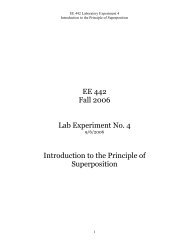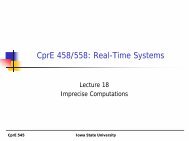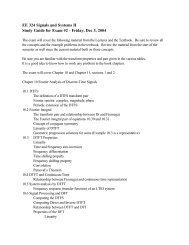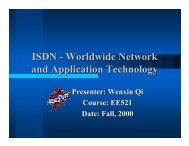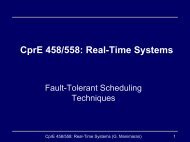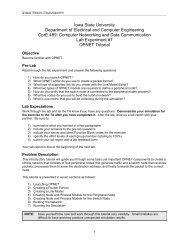Sockets Tutorial PDF file
Sockets Tutorial PDF file
Sockets Tutorial PDF file
Create successful ePaper yourself
Turn your PDF publications into a flip-book with our unique Google optimized e-Paper software.
The Berkely API (Application Protocol Interface)<br />
Helpful Notes<br />
By<br />
Pallab Datta<br />
Feb 20, 2001
The Berkeley API<br />
An application program interface(API) allows Application programs to<br />
access certain resources through a predefined and preferably consistent<br />
interface.<br />
The socket interface is now available on many UNIX machines.<br />
Another popular socket interface that was derived from BK-socket is<br />
called the Windows Socket or Winsock.<br />
The socket mechanism allows programmers to write appl programs<br />
easily without worrying about the underlying networking details.<br />
In a typical communication session one application operates as a server<br />
and the other application acts as the client. The server provides services<br />
upon request from the client.<br />
Two modes of service : Connection-oriented ,Connectionless<br />
Connection-oriented : Reliable ,setup overhead<br />
Connectionless : Unreliable, “Best –Effort” Service, No setup overhead
server<br />
Socket()<br />
“socket calls for connection-oriented com”<br />
-------------------------------------------------<br />
Bind()<br />
Listen()<br />
Accept()<br />
Blocks :req->client<br />
Read()<br />
Write()<br />
Close()<br />
data<br />
client<br />
Socket()<br />
Connect()<br />
Write()<br />
Read()<br />
Close()
server<br />
Socket()<br />
Bind()<br />
Recvfrom()<br />
Block:data
Appl 1 Appl 2<br />
socket<br />
socket<br />
Underlying comm<br />
protocols<br />
Underlying comm<br />
protocols<br />
Comm N/W<br />
Communication through the socket interface
SOCKET CALLS FOR CONNECTION-ORIENTED COMM<br />
* Server -> calls socket() -> creates a TCP socket.<br />
The bind() then binds the port address of the server to the socket.<br />
The listen() call then turns the socket into a listening socket that can<br />
accept incoming connections from clients.<br />
Finally the accept() call puts the server process to sleep until a client<br />
request arrives..!!<br />
NOW Client calls socket() -> creates a active socket on the client side<br />
Connect() call-> establishes the TCP connection to the server with the<br />
specified destination socket address.When the TCP connection is<br />
completed the accept() function at the server wakes up and returns the<br />
descriptor for the given connection.<br />
Client and server are now READY to exchange information. Finally both<br />
the server and client closes connection through close().
SOCKET CALLS FOR CONNECTIONLESS COMMUNICATION<br />
* NO connection is established prior to communication.<br />
In the same way the server calls socket()-> active socket is created at the<br />
server side. Then it binds the port no of the server to the socket by using<br />
the bind() call.<br />
Then it calls recvfrom() -> puts the server to a waiting state till the<br />
arrival of some request from the client.<br />
* At the client end socket()-> creates an active socket at the client end.<br />
Bind() -> binds the port # at the client end to the active socket created.<br />
The recvfrom() call at the server end returns, when a complete UDP<br />
datagram has been received from the client side.<br />
Finally both the client and the server terminates their socket connection<br />
through the close() call.
SOCKET SYSTEM CALLS<br />
* Include header <strong>file</strong>s and <br />
* int socket( int family, int type, int protocol);<br />
family -> identifies the family by address or by protocol.The<br />
address family identifies a collection of protocols with the same address<br />
format. The protocol family identifies a collection of protocol having<br />
same architecture. e.g: AF_UNIX –used for comm on UNIX machines.<br />
AF_INET- used for internet comm using TCP/IP protocol. The protocol<br />
family is identified using the PF_ prefix.<br />
type -> identifies the semantics of communication.<br />
SOCK_STREAM : provides data delivery service as a sequence of<br />
bytes and does not preserve message boundaries.SOCK_DGRAM :<br />
provides data delivery in blocks of bytes..!!<br />
protocol-> protocol to be used . e.g: default protocol for each family<br />
and type. Default protocol for SOCK_STREAM type with AF_INET<br />
family is TCP. For SOCK_DGRAM with AF_INET is UDP.
SOCKET SYSTEMS CALLS( contd…..)<br />
int bind( int sd, struct sockaddr *name, int namelen); This call is used to<br />
assign an address to a socket.<br />
sd -> socket descriptor returned by socket call.<br />
name ->pointer to an address structure that contains the local IP<br />
address and the port #.<br />
namelen-> is the size of the address structure in bytes<br />
Return value : 0 on success and –1 on failure.<br />
sockaddress structure : struct sockaddr {<br />
u_short sa_family; /*address family */<br />
char sa_data[14] /* address */ }
SOCKET SYSTEMS CALLS (contd…)<br />
An application program using the Internet family should use the<br />
sockaddr_in structure to assign values and should use the sockaddr<br />
structure only for casting purposes in function arguments.<br />
struct sockaddr_in {<br />
}<br />
u_short sin_family; /* AF_INET */<br />
u_short sin_port; /* TCP or UDP port */<br />
struct in_addr sin_addr /* 32-bit IP address */<br />
char sin_zero[8] /* unused */<br />
sin_addr -> local IP add.For a host with multiple IP addresses, sin_addr<br />
is typically set to INADDR_ANY to indicate that the server is willing to<br />
accept comm through any of its IP addresses.<br />
sin_zero ->Is used to fill out struct sockaddr_in to 16 bytes.
MORE SOCKET CALLS ..!!<br />
Client establishes a connection on a socket by calling connect(). The<br />
prototype for connect is :<br />
int connect (int sd, struct sockaddr *name , int namelen);<br />
sd-> socket descriptor returned by the socket call.<br />
name -> points to the server address structure.<br />
namelen-> amount of space in bytes specified by name.<br />
For connection oriented comm connect attempts to setup a virtual ckt<br />
between the server and the client.<br />
For connectionless comm connect stores the server’s add, so that<br />
client can use the socket descriptor when sending datagrams instead<br />
of specifying the server’s add each time..!!!<br />
Return value :0 on success and –1 on failure.
MORE SYS CALLS….<br />
The server can accept a conn-req from client after issuing listen()<br />
int listen (int sd, int backlog);<br />
sd-> socket descriptor returned by the socket() call.<br />
backlog-> max no of connection requests that the sys should queue<br />
while it waits for the server to accept them(usually 5..!!).<br />
Return value : success is 0, failure is –1.<br />
After this the server accepts the connection request by calling accept().<br />
int accept(int sd, struct sockaddr *addr, int *addrlen)<br />
addr ->pointer to an add structure that accept fills in with the clients IP<br />
addr and Port No.addrlen->specifies the amount of space pointed to by<br />
addr before the call. If no conn req’s are pending accept will block the<br />
caller until a connection arrives.It returns a new socket descriptor.
SYS CALLS FOR DATA TRANSFER ..!!<br />
Clients and servers can exchange data using write and sendto.<br />
write() call is used for connection-oriented comm. A connectionless<br />
client may also call write if the client has executed a connect call..!!<br />
sendto() is used in connectionless communication.<br />
int write( int sd, char *buf , int buflen);<br />
int sendto(int sd, char *buf, int buflen, int flags, struct sockaddr *addrp,<br />
int addrlen);<br />
Return value : returns the no of bytes transmitted on success and –1 on<br />
failure.<br />
int read(int sd, char *buf , int buflen);<br />
int recvfrom(int sd, char *buf, int buflen, int flags, struct sockaddr<br />
*addrp, int addrlen);<br />
Return value : returns the no of bytes received on success and –1 on<br />
failure.<br />
Terminate the socket connection –close(int sd).
NETWORK UTILITY FUNCTIONS<br />
To convert a domain name to an IP add include ,<br />
and .<br />
struct hostent {<br />
char *h_name; /* official name or host*/<br />
char **h_aliases; /*alias name this host uses*/<br />
int h_addrtype ; /* address type */<br />
int h_length ;/* length of address */<br />
char **h_addr_list; /* list of addr’s from name server*/<br />
}<br />
NAME TO ADDRESS TRANSLATION FUNCTIONS<br />
* struct hostent *gethostbyname (char *name);<br />
Returns NULL on error. It obtains information from the <strong>file</strong> /etc/hosts or<br />
from the name server.<br />
* struct hostent *gethostbyaddr( char *addr, int len, int type);<br />
Returns the same information as the above.
IP ADDRESS MANIPULATION FUNCTIONS<br />
For IP address manipulation the ,,<br />
and are to be included.<br />
The two functions used for this purpose are :<br />
char *inet_ntoa( struct in_addr in) -> Takes a 32 bit-IP add and returns<br />
the corresponding IP add in dotted format.<br />
unsigned long inet_addr( char *cp)-> Takes the host address in dotted<br />
format and returns the IP addr as a 32 bit IP addr in network byte order.
IMPLEMENTING AN ECHO SERVER..<br />
Program at the “server –end”<br />
* Create a stream socket<br />
if((sd= socket(AF_INET,SOCK_STREAM,0) ) = = -1) {<br />
fprintf(stderr, “cant create a socket”);<br />
exit (1); }<br />
* Bind some add to the socket<br />
bzero((char *)& server ,sizeof(struct sockaddr_in));<br />
server.sin_family =AF_INET;<br />
server.sin_port = htons(port);<br />
server.sin_addr.s_addr = htons(INADDR_ANY);<br />
* Queue up to 5 connect requests<br />
listen(sd ,5);
* Code to handle connection req from client<br />
if ((new_sd =accept(sd, (struct sockaddr *)&client ,&client_len)) = =-1)<br />
{ fprintf(stderr, “can’t accept client”);<br />
exit(1); }<br />
* Reading bytes ….<br />
bytes_to_read = MAXBUFLEN; bp =buf ;<br />
while ((n= read(new_sd,bp ,bytes_to_read)) >0 ) {<br />
bp +=n;<br />
bytes_to_read -=n; }<br />
write(new_sd, buf , MAXBUFLEN); }<br />
* Closing socket connection at client and server<br />
close(new_sd);<br />
close(sd);
* Create a socket stream<br />
Program Executing at the Client-end<br />
if((sd= socket(AF_INET,SOCK_STREAM ,0) = = -1) {<br />
fprintf(stderr, “can’t create a socket”);<br />
exit(1); }<br />
* Bind address to the socket at the client end<br />
bzero((char *)&server ,sizeof(struct sockaddr_in));<br />
server.sin_family =AF_INET;<br />
server .sin_port = htons(port);<br />
if((hp = gethostbyname(host)) = = NULL) {<br />
fprintf( stderr, “Can’t get server’s address..!!);<br />
exit(1); }<br />
* Connecting to the server<br />
if(connect(sd , (struct sockaddr *)&server, sizeof(server)) = = -1){<br />
fprintf(stderr, “can’t connect..!!”); exit(1); }
* Input from the user ..<br />
gets(sbuf); /* sbuf -> receive input buffer */<br />
write(sd, sbuf , MAXBUFLEN); /* send the buf to the server*/<br />
* Receive data from the server side<br />
bp =rbuf; bytes_to_read = MAXBUFLEN;<br />
while((n = read(sd, bp , bytes_to_read)) > 0) {<br />
bp + = n; bytes_to_read - = n; }<br />
* Closing connection at client side<br />
close(sd);
SOME IMP WEB-SITES FOR REFERENCE<br />
http://www.cs.rpi.edu/courses/netprog/lectures/ppthtml/sockets/<br />
http://orca.stm.edu/~sayfarth/network_pgm/net-6-6-1.html<br />
http://www.linuxgazette.com/issue47/bueno.html<br />
Reading references : UNIX Network Programming by<br />
W.Richard Stevens.
Here is a list of links to <strong>Sockets</strong> information as provided by students to Pallab:<br />
http://www.ecst.csuchico.edu/~beej/guide/net/<br />
http://www.cs.utah.edu/dept/old/texinfo/glibc-manual-0.02/library_15.html<br />
http://compnetworking.about.com/compute/compnetworking/cs/socketprogramming/<br />
http://fag.grm.hia.no/it2200/ovinger/Ccourcesocket.htm<br />
http://www.freesoft.org/CIE/Topics/3.htm<br />
http://www.ece.wpi.edu/courses/ee535/hwk97/hwk4cd97/murti/node3.html<br />
http://www.cs.rpi.edu/courses/netprog/lectures/ppthtml/sockets/<br />
http://www.linuxgazette.com/issue47/bueno.html<br />
http://orca.stm.edu/~sayfarth/network_pgm/net-6-6-1.html<br />
http://www.cs.mun.ca/~rod/Winter98/cs4759/berkeley.html<br />
http://www.stardust.com/winsock/ws1.1_api/<br />
http://guir.berkeley.edu/projects/javadoc/help-doc.html<br />
http://www2.cc.unca.edu/BerkeleyDB/<br />
http://eel.st.usm.edu/~seyfarth/network_pgm/net-6-6-1.html<br />
http://www.sockets.com/ms_icmp.htm<br />
http://bmrc.berkeley.edu/research/publications/1996/112/node6.html<br />
http://www.cis.ohio-state.edu/htbin/rfc/rfc2292.html<br />
http://casaturn.kaist.ac.kr/~sikang/os/socket/<br />
http://www3.tsl.uu.se/~micke/WASA/Control_via_internet/control_via_net.htm<br />
l<br />
http://www.openvms.compaq.com:8000/721final/6523/6523pro_016.html<br />
http://wwwclassic.be.com/developers/may_dev_conf/transcripts/approachingnetworking/<br />
http://now.cs.berkeley.edu/Fastcomm/fastcomm.html<br />
http://www.cs.tamu.edu/course-info/cpsc463/tutorial/<br />
http://www.cs.berkeley.edu/~dmartin/qt/topicals.html<br />
http://www.ieng.com/univercd/cc/td/doc/product/software/ioss390/ios390sk/sklibfun.htm<br />
http://www.mtholyoke.edu/acad/compsc/Honors/Hu-Imm-Lee/ch2.htm<br />
http://www.internet2.edu/qos/may98Workshop/html/apiprop.html The<br />
http://www.uwo.ca/its/doc/courses/notes/socket/<br />
http://www.pcquest.com/may99/socket.asp<br />
http://sunsite.iisc.ernet.in/collection/virlib/tcpip/parker/tyt14fi.htm<br />
http://kitap.selcuk.edu.tr/tcpip/Teach_Yourself_TCPIP/tyt14fi.htm<br />
http://blondie.mathcs.wilkes.edu/~sullivan/sockets/<br />
http://www.netcon.com/docs/socket.htm<br />
http://www.ecst.csuchico.edu/~beej/guide/net/<br />
http://www-users.cs.umn.edu/~bentlema/unix/advipc/ipc.html<br />
http://world.std.com/~jimf/papers/sockets/sockets.html<br />
http://www.s390.ibm.com/products/tpf/v3n2a4.html<br />
http://www.cs.utexas.edu/users/dragon/cs378/resources/sockets.html<br />
http://www.cis.temple.edu/~ingargio/cis307/readings/unix4.html<br />
http://www.fortunecity.com/skyscraper/arpanet/6/cc.htm<br />
http://www.extreme.indiana.edu/~gannon/c212.f96/c212w14.html<br />
http://troyda.eas.muohio.edu/623/L1-14/L1-14.html<br />
http://wwwcs.dongguk.ac.kr/~jiwon/main/network_tp/SOCKET1/
http://www.acornsw.com/cujcd/HTML/15.05/ROSS/ROSS.HTM<br />
http://www.sparc.spb.su/jjb/Docs/internet/sockets<br />
http://www.sockaddr.com/The<strong>Sockets</strong>Paradigm.html<br />
http://www.whisqu.se/per/docs/general28.htm<br />
http://www.adetti.iscte.pt/ADETTI/Security/HowTo/net_programming/winsick3.htm.



